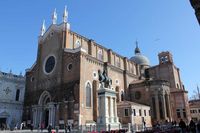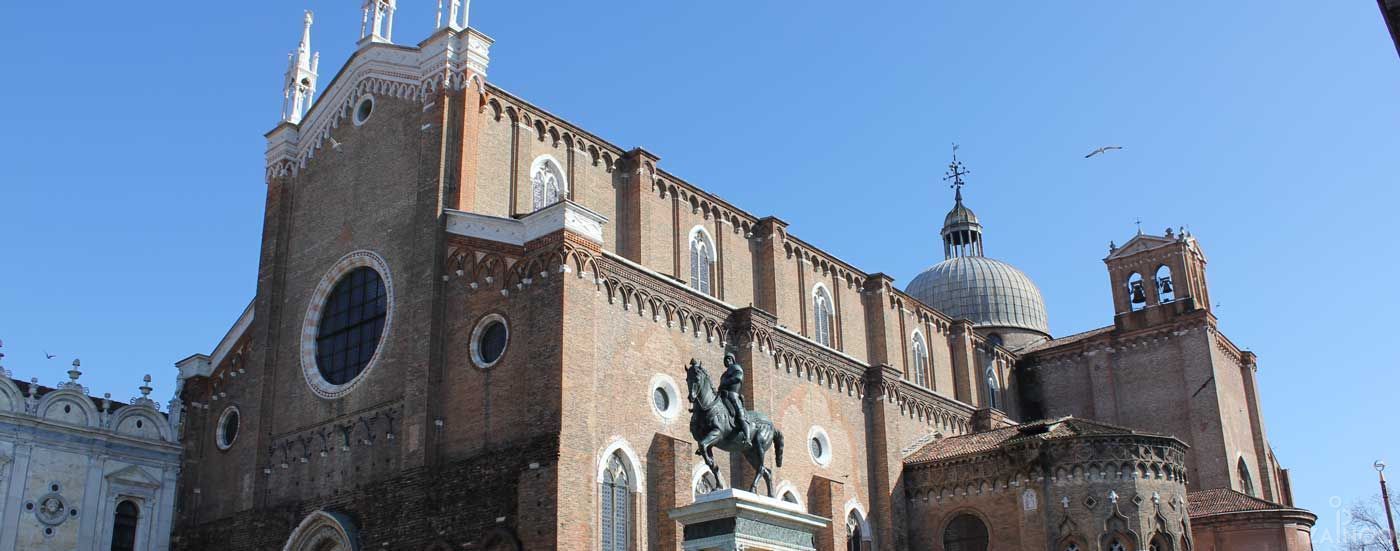San Zanipolo
Church
Basilica Santi Giovanni e Paolo – San Zanipolo
The largest church in Venice
The Basilica of Santi Giovanni e Paolo – in Venetian dialect also called San Zanipolo – is the largest religious building in Venice. The brick church measures almost 102 metres in length and is 35 metres wide. Together with the Colleoni equestrian statue at the square and the Scuola San Marco, the complex is an impressive composition of buildings from Gothic and Renaissance eras. The building of the church took almost 200 years and was a project of the Dominicans in Venice. The Venetians themselves often call San Zanipolo the pantheon – the bones of no less than 27 Venetian Doges have found their final resting place in the Basilica.
Inside the Basilica Santi Giovanni e Paolo
The Basilica may appear simple from the outside, but inside it houses a magnificent interior. The three-nave building is supported by thick pillars and at the moment you enter it appears very impressive due to the open view to the light-filled vestibule. 27 elaborately decorated tombs in Gothic and Renaissance style are distributed over the whole church. On the west wall just next to the entrance you can find the colossal tombs of the Doges Pietro, Giovanni and Alvise Mocenigo. They mark the transition from Renaissance to Baroque very effectively. A Renaissance tomb with Hercules statues is followed by the colossal Baroque grave over the main entrance.
In the left aisle of San Zanipolo
In the left aisle three grave monuments deserve special attention. First you reach the grave of the Doge Nicolo Marcello, designed by Pietro Lombardo. Tommaso Mocenigo’s tomb is a fine example of the transitional style from late Gothic era to Renaissance. For the first time a fabric canopy was used here. Also with fabric canopy in the early Renaissance style is the tomb of Pasquale Malipiero. In the adjoining sacristy there is an altarpiece by Palma the Younger and a beautiful ceiling painting by Marco Vecellio. One of the most ancient tombs in the Basilica can be found in the Cappella Cavalli on the front side. This is the final resting place of the Doge Giovanni Dolfin from the 12th century. Not far away are the graves of Doge-Family Venier. Antonio, Francesco and Sebastiano Venier are buried here. The Cappella del Rosaio was built in honour of the naval victory at Lepanto (1571) against the Turks. Ceiling frescos by Paolo Veronese decorate the chapel.
The Presbytery
The eye-catching main altar is designed as a triumphal arch notice in the main apse. Here are the statues of the two patron saints John and Paul. Four more Doge tombs are worth mentioning here. Right at the beginning of the presbytery you will see the Gothic tomb of the Doge Marco Corner on the left. A few steps away you can see the grave of Doge Andrea Vendramin under a Roman triumphal arch in the style of the Renaissance. On the opposite wall there are the tombs of Doge Leonardo Loredan and Michele Morosini.
In the right aisle of San Zanipolo
Coming from the main apse of the right aisle, you will reach the front of the right transept. Some beautiful paintings adorn it – among them an altarpiece of Lorenzo Lotto, which is influenced by Titian. In the adjacent Cappella di San Domenico a remarkable ceiling fresco by Giovanni Battista Piazzetta deserves special attention. It is principally the work of the Venetian Rococo in the Basilica of Santi Giovanni e Paolo. Leaving the chapel, you soon reach the high baroque tomb of the Doge Silvestro Valier. He was the last Doge of Venice and was buried in 1700 in the Basilica. On the way back to the main entrance you pass the small Chapel of Peace with a Byzantine icon and an altar with a painting by Giovanni Bellini.
In front of the Basilica Santi Giovanni e Paolo
Right next to the Basilica is the Scuola Grande di San Marco. It was once the location of the goldsmiths and silk merchants and today serves as the mainentrance to the municipal hospital. The magnificent Renaissance facade was designed by Petro Lombardo. Outside of the Basilica, in the middle of the square, stands the Colleoni equestrian statue. It was modelled on Donatello’s statue in Padua and is the second new equestrian statue of the modern era. Rider and horse are shown in motion. The statue shows the captain Bartolomeo Colleoni, who conquered the hinterland of Venice. After his death in1475 he bequeathed his entire fortune to the Doge’s Republic for a monument in front of San Marco. Unfortunately he forgot to explicitly mention the Basilica di San Marco and so the monument was quickly erected in front of the Scuola Grande di San Marco.
Entrance
€ 2,50
Accessibility
Landing stage: Fondamenta Nuove or Ospidale







Tweet